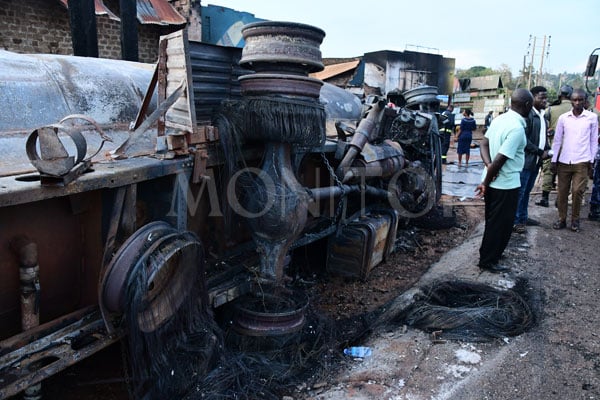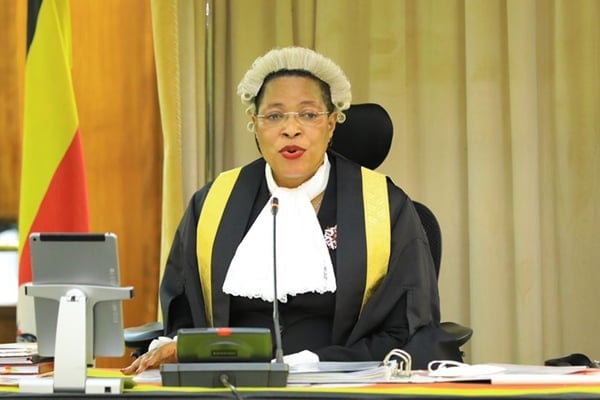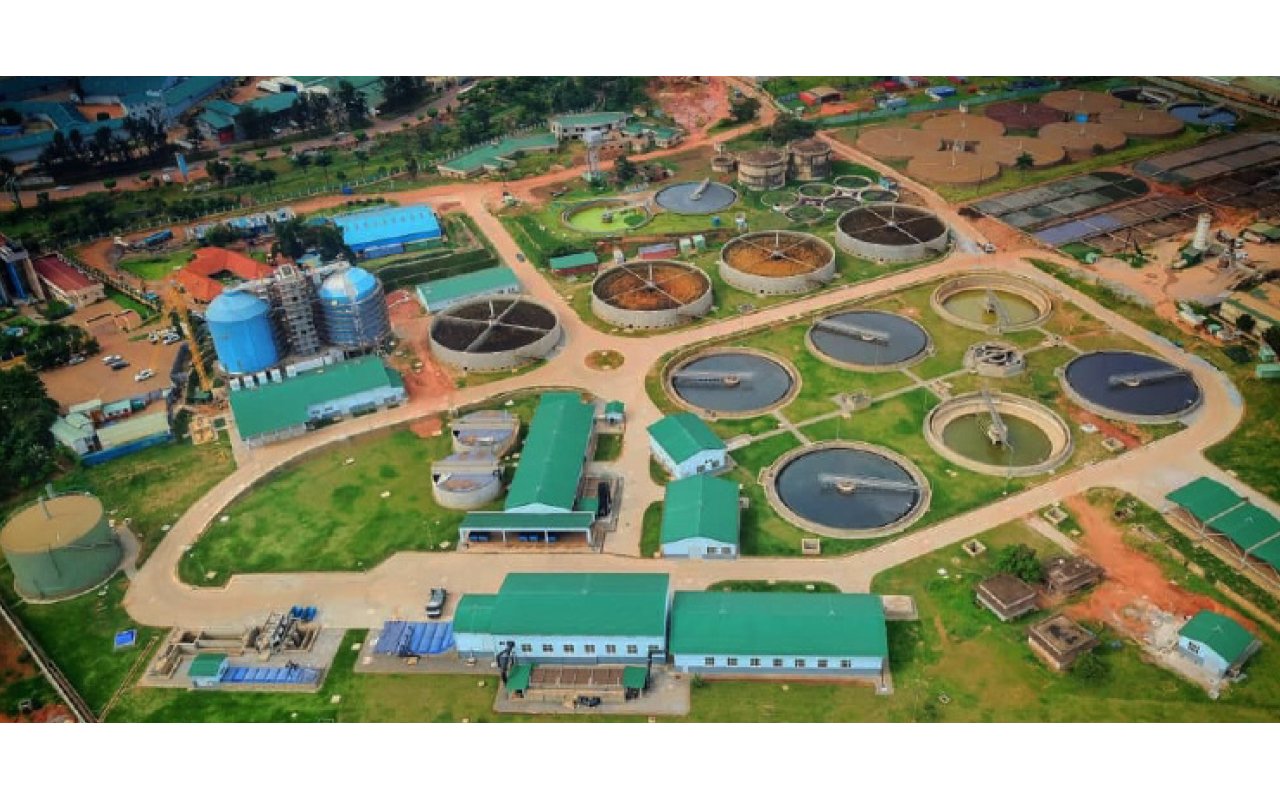
Some of the shops that were destroyed after a fuel tanker exploded in Kigogwa Town, Wakiso District on October 22, 2024. PHOTO/ABUBAKER LUBOWA
The Kigoogwa fuel tanker inferno that by Thursday had claimed 15 lives has opened an old wound stemming from fuel freighting. With Uganda’s daily fuel consumption estimated to be around 6.5 million litres, a string of fuel storage deficits have contrived to keep an unusually high number of fuel tankers on the country’s roads.
Since Vivo Energy and TotalEnergies, the country’s major bulk fuel suppliers, cannot fully stock their depots on account of them being in the central business district, they—much like the other small suppliers—have to keep fuel tankers on the road to replenish their stocks. Besides the expenses that the supplies have to incur while hauling in new supplies, having many fuel tankers on Uganda’s often gridlocked roads presents a clear and present danger. It was not until the mid-1990s that Uganda stopped hauling in petroleum products via a rail-water transport system. Mahathi Infra Uganda Ltd, a consortium of private investors, has revived the fortunes of the Kawuku oil jetty.
Two ships—MT Kabaka Mutebi II and MT Elgon—haul petroleum products in from Kenya’s Kisumu port to Kawuku via Lake Victoria. Yet fuel tankers plying the Northern Corridor remain in their legions. And, as the blaze in Kigoogwa showed this past week, it is not without any consequences. Incidentally, the stricken fuel tanker overturned in a congested urban area along the Kampala-Gulu highway. A petrol station was a stone’s throw away from where the accident played out.
“It is a common occurrence to find filling stations mushrooming in a given urban area like Mbale City clearly without paying attention to the existent regulations,” Mr Clyan Gimei, a resident of the city, told Saturday Monitor.Indeed, there are over 10 filling stations in a 1.4km stretch from the clock tower in Mbale town to Islamic university in Uganda (IUIU) in Nkoma along Mbale-Soroti road.
“This is a clear indicator that the 2022 Physical Planning Conditions for location of fuel stations regulations that require fuelling stations to be 200 metres apart and away from densely populated areas is breached,” Mr Gimei said, adding, “Some of these stations are located in front of hospitals, markets and a university.”
Ms Irene Bateebe, the Permanent Secretary of the Energy and Mineral Development ministry, says the issues of localisation of fuel stations/installation fall within the ambit of the local authority where the fuel station is located.
“The [National] Physical Planning Board has issued guidelines to guide them in doing so. The ministry's role is to ensure petroleum facility standards are met,” she said. Clear and present danger yet the mushrooming of filling stations in places where they ought not to continue to worry many. Mr Enock Abaine, the Commandant of the Environmental Protection Police Unit (EPPU), told Saturday Monitor that the National Environment Management Authority (Nema) has a team that runs the rule over petrol stations. “If you have a particular site you can let us know and we verify if they have an Environmental Impact Assessment (EIA) Certificate. I will take it up and we will verify,” Mr Abaine said.
An EIA is a critical examination of the effects of a project on the environment. It sets out to identify both negative and positive impacts of any development activity.
"No petrol station can be established without clearance from Nema. What concerns me is seeing petrol stations mushrooming even in residential and public areas, which is not ideal," Mr James Kutosi, the Senior Communication Officer of Mbale City Council, revealed, adding, “When someone acquires a plot and Nema clears the establishment of a petrol station, it becomes difficult for the council to deny approval. If we do, we risk being sued by the proprietors. If one petrol station catches fire, all neighbouring residents will be affected. We need to conduct thorough checks to ensure the safety of our people.”
Dr Barirega Akankwasah, the Executive Director of Nema, admits that the proliferation of fuel stations remains a great concern for the government. “That’s why Physical Planning Standards for fuel stations were developed by the government in 2022 and launched. So it is imperative that the Physical Planning Committees ensure that these standards are enforced,” said Dr Akankwasah.
The Nema supremo said Physical Planning Committees and the Building Control Committees should not give the all clear for fuel stations to be established in risky areas like markets, factories, highly congested residential areas, among others.
"This is because in case of fire, one has to minimise damage. The farther apart the fuel stations are the better. Most importantly, movement of fuel tankers is even a greater danger than the fuel stations themselves,” he said, adding that the underground storage at fuel stations may not be a big fire risk due to low oxygen levels.
Dr Akankwasah made clear the need to restrict movement of fuel tankers to night time “when there is less traffic and congestion.” Mr Johnson Okwi, an environmentalist, says establishment of a petrol station in Uganda requires planning and adherence to a detailed regulatory framework. “I think these measures, while stringent, are in place to protect the community, environment, and investors, ensuring that petrol stations contribute positively to Uganda’s infrastructure and economy,” Mr Opolot told the Monitor.
Low rate of complianceYet a report by the Auditor General indicates that a compliance assessment of 3,132 fuel stations returned disturbing results. More than half of the fuel stations didn’t meet the required standards. According to the report for the period ended June 2022, only 1,359 out of the 3,132 fuel stations in eastern, western and central Uganda were compliant. This means that 57 percent of the fuel stations assessed did not meet different crucial clauses of the US 947-1:2019 standards.
According to the Uganda National Bureau of Standards (UNBS), the US 947-1:2019 “covers the siting, design and construction of service stations, installation and operation of equipment in service stations for handling, storage and dispensing of petroleum products and their derivatives, other than equipment used in transportation.” UNBS also says that standard was withdrawn and replaced by the US EAS 977:2020. The standard “provides guidelines for the installation of underground storage tanks of individual capacity not exceeding 125 000 litres.”

A motorist fuels a vehicle at a petrol station. The increasing number of fuel stations being established, especially in areas where they may not be suitable or safe, is causing significant concern. PHOTO/COURTESY OF SHUTTERSTOCK
It also “covers guidelines on installation for pumps/dispensers and pipework at service stations and consumer sites” as well as “the installation of pressurised underground storage tanks for auto-gas.” Yet deep-seated concerns about fuel stations continue to hold sway. Environmentalists are particularly worried about possible fuel leaks, which could contaminate local soil and water sources, posing long-term risks to both the environment and public health.
In the Auditor General’s report for year ended June 30, 2019, it was revealed that: “Of 984 fuel stations in the Ministry of Energy database, 363 fuel stations did not poses environmental impact assessments, 205 fuel stations did not possess construction permits and 698 fuel stations did not possess construction completion certificates.
The Auditor General’s report further noted that out of the 1,695 fuel stations inspected over a period of three years, only 10 (one percent) carried out environmental audit reports, 236 (14 percent) carried out training of staff on health and safety, and only 252 (15 percent) had proper drainage.What next?
A source in the Energy and Mineral Development ministry told this publication on condition of anonymity that there are more than 2,300 unlicensed fuel stations across the country. Government statistics indicate that by September 2020 there were 1,047 licensed retail petrol stations in the country. When contacted for a comment, Ms Sylvia Kirabo, the Principal Public Relations Officer at UNBS, explained that the regulation of petrol stations falls under the mandate of the Ministry of Energy.
“I sent a request to the Ministry of Energy for information regarding the mushrooming petrol stations, but I have yet to receive a response because this is within their jurisdiction,” Ms Kirabo stated.
Data from UNBS indicates that as of February 2024, there were 4,881 retail fuel stations nationwide, with monitoring coverage reaching 83 percent. In 2021, the National Physical Planning Board (NPPB) revealed plans to carry out countrywide demolition of new fuel stations in a move aimed at reducing the risk of fire outbreaks in urban areas. Earlier, in November of 2020, NPPB had directed Chief Administrative Officers (CAOs), City clerks, and municipal town clerks to suspend approval of development applications for fuel stations until developers meet operation guidelines. But the suspension was lifted shortly.
Ms Amanda Ngabirano, the NPPB chairperson, recently said: “Petrol stations are supposed to be three kilometres apart, but now they are operating 100 metres and less from each other.” Mr Luke Lokuda, the CAO of Mbale District, said the petrol stations are not supposed to be in the residential areas and wetlands. “People should follow the right procedures while putting up the petrol stations.”
WHAT NEXT?
A source in the Energy and Mineral Development ministry told this publication on condition of anonymity that there are more than 2,300 unlicensed fuel stations across the country. Government statistics indicate that by September 2020, there were 1,047 licensed retail petrol stations in the country. When contacted for a comment, Ms Sylvia Kirabo, the principal public relations officer at UNBS, explained that the regulation of petrol stations falls under the mandate of the Ministry of Energy. “I sent a request to the Ministry of Energy for information regarding the mushrooming petrol stations, but I have yet to receive a response because this is within their jurisdiction,” Ms Kirabo stated.
Data from UNBS indicates that as of February, there were 4,881 retail fuel stations nationwide, with monitoring coverage reaching 83 percent. In 2021, the National Physical Planning Board (NPPB) revealed plans to carry out countrywide demolition of new fuel stations in a move aimed at reducing the risk of fire outbreaks in urban areas.
Earlier, in November of 2020, NPPB had directed chief administrative officers (CAOs), city clerks, and municipal town clerks to suspend approval of development applications for fuel stations until developers meet operation guidelines. But the suspension was lifted shortly. Mr Luke Lokuda, the CAO of Mbale District, said the petrol stations are not supposed to be in the residential areas and wetlands. “People should follow the right procedures while putting up the petrol stations.”






